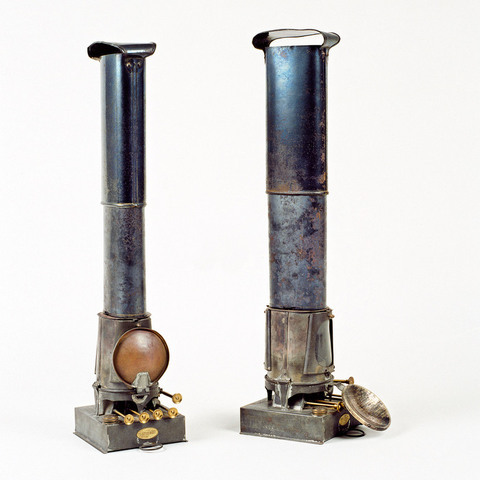Lanternes de projection
Fiche détaillée
Type de l'appareil
deux lanternes de projection (1 & 2) montées sur leur caisse de transport en bois (7) ; corps en métal peint ; objectifs en cuivre verni, à crémaillère et loquets ; deux lampes à pétrole (3 & 4) à quatre mèches ; cheminées ; double peigne oscillant en cuivre verni (5) ; réservoir de pétrole et entonnoir (6)
Auteurs
Hughes William Charles
London, Brewster House, Mortimer Road Kingsland, Middlesex
Fabricants
William Charles Hughes
Londres, Brewster House, 82 Mortimer Road
Utilisateurs
Hughes William Charles
London, Brewster House, Mortimer Road Kingsland, Middlesex
Distributeurs
Informations non disponibles
Sujet du modèle
Informations non disponibles
Objectif
condensateurs 10 cm de diamètre et objectifs 4 cm de diamètre
Taille de l'objet
Ouvert :
Longueur : 45.5 cm
Largeur : 47.5 cm
Hauteur : 80 cm
Fermé :
Informations non disponibles
Diamètre :
Informations non disponibles
Taille de la boîte de transport
Longueur : 45.5 cm
Largeur : 47.5 cm
Hauteur : 28 cm
Remarques
Etiquettes de marque : "W.C. Hughes Optician, Brewster House, 82, Mortimer Ro., Kingsland Rd.N. London".
"Hughes' new pattern Pamphengos. Nearly 3000 sold... The body is not of Russian Iron, which rusts, but made of best Cornwall tin, beautifully Japanned. 4-inch best English compound condensers, mounted in brass screw cells ; substantial solid brass fronts and slide holders, brass draw tubes (collapsable), to which is adapted Mr Hughes' high class double combination large diameter lenses, with diaphragm mount, flashing shutter and solt for coloured glasses, rackworck and pinion with double milled heads, or Hughes' patent rotary motion for focussing, which must be notified in ordering. The chimney is held firmly on the lamp by clamping screws on the collar of lantern. Complete in well-made polished case, £ 6. 6, Pair in case for dissolving views, £ 12. 12" ([Charles D. Bishop, W.C. Hughes], The Art of projection and complete magic lantern manual, by an expert, London, E.A. Beckett, 1893, p. 181).
"This lovely pair of Hughes lanterns was purchased only a few years ago from a fish'n chip shop proprietor in Mickleover, near Derby. When bought they were totally complete (including many years of accumulated grime) and came with all the accessories... The original lacquer on these lanterns is a rich golden glow, unmarked by the passage of time and particulary so on the beautiful engineered fan. The object of having two lanterns instead of one is to produce dissolving views. Each side of the fan has a deeply serrated edge which gradually uncovers the front of one lantern and covers that of the other. When limelight is used the same effect is achevied by turning the lights up and down. Whilst this type of dissolving mechanism was not particulary popular, by virtue of the fact that the cost of a limelight illuminated biunial did not greatly excede that of two oil lanterns, it is nevertheless a splendid example of Victorian ingenuity" (Mike Smith, "Pamphengos Pair", The New Magic Lantern Journal, Vol. 1, n° 3, mars 1980).
"The Pamphengos lamp is claimed by the maker to give sufficient light to show coloured photographs twelve feet in diameter. This lamp has four wicks, each two inches wide, placed parallel to each other and enclosed in a circular chamber of metal which has one aperture on the side next to the picture and another one opposite, outside of which the reflector is placed, to protect it from the great heat inseparable from oil lamps. The pieces of glass closign these apertures are annealed, and a fracture by heat rarely occures. There is very little metal used to connect the chamber to the oil reservoir, so that an accident by overheating is improbable. The chamber itself, being circular, nearly resembles the glass chimney of an ordinary domestic lamp ; this ensures perfect combustion, the light being whiter than that produced by the cheaper forms of lamp" (C. Goodwin Norton, 1895, cité par Mike Smith, op. cit.).
Bibliographie
[Charles D. Bishop, W.C. Hughes], The Art of projection and complete magic lantern manual, by an expert, London, E.A. Beckett, 1893, p. 13-19, p. 180-181.
The New Magic Lantern Journal, Vol. 1, n° 3, mars 1980.




